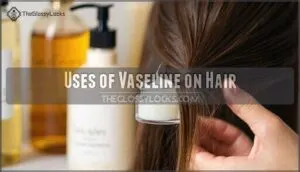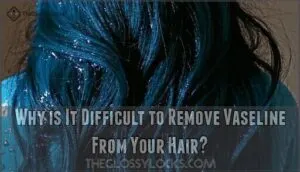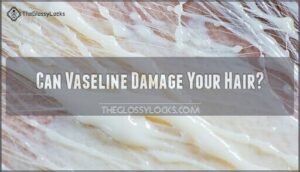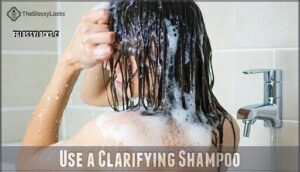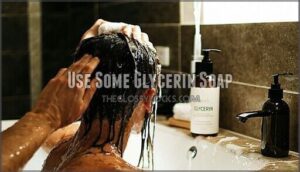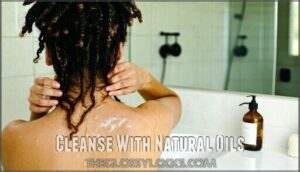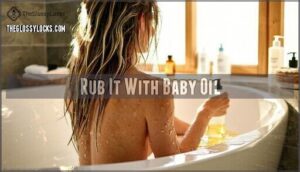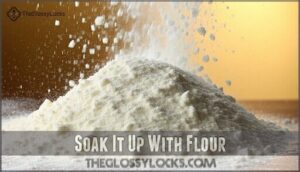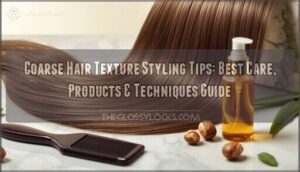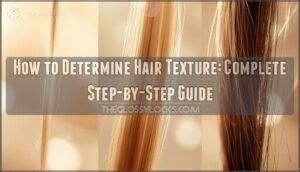This site is supported by our readers. We may earn a commission, at no cost to you, if you purchase through links.
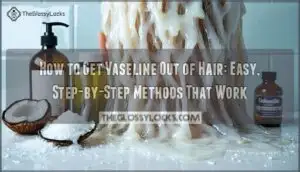
Instead of waiting days for your hair to bounce back, you want answers that work. Rescue isn’t in endless shampooing or panic-cutting; it starts with a handful of clever tricks passed down by those who’ve wrangled their own stubborn strands and lived to share what works.
Table Of Contents
- Key Takeaways
- What is Vaseline?
- Uses of Vaseline on Hair
- Why is It Difficult to Remove Vaseline From Your Hair?
- Can Vaseline Damage Your Hair?
- How to Remove Vaseline From Your Hair
- Q&A
- Frequently Asked Questions (FAQs)
- How can you get Vaseline out of your hair?
- What is the easiest way to remove Vaseline?
- What happens if Vaseline gets in hair?
- Will Dawn dish soap get Vaseline out of your hair?
- What are alternatives to Vaseline for hair care?
- How often should Vaseline be used on hair?
- Is Vaseline safe to use on color-treated hair?
- Can Vaseline be used on children’s hair?
- Are there any natural remedies for removing Vaseline from hair?
- How long does Vaseline typically stay in hair?
- Conclusion
Key Takeaways
- Vaseline clings to hair because it’s made of petroleum jelly that repels water, requiring oil-based methods like clarifying shampoo, dish soap, or natural oils to break down the greasy buildup before washing.
- Absorbing the grease first with household powders like baking soda, baby powder, or flour makes removal easier by lifting the residue before you shampoo.
- Overusing Vaseline on hair can cause follicle blockage, scalp buildup, and hair breakage over time, despite its temporary moisture-sealing benefits.
- Most Vaseline mishaps can be fixed within two washes using the right combination of absorbent powders and degreasing agents like dish soap or clarifying shampoo.
What is Vaseline?
When you hear the word Vaseline, you might picture that little tub of slick jelly that’s been a staple in medicine cabinets for generations. Its unique composition—those thick hydrocarbon oil chains—makes it both a powerful moisture-locker and, for some, a stubborn, comedogenic companion when it lands on your hair or scalp.
Made from a mix of mineral oil and natural waxes, Vaseline’s history traces back to the late 1800s when it was first refined for use as a skinsafe, healing ointment.
Uses of Vaseline on Hair
For something so simple, Vaseline tends to stir up plenty of opinions about whether it’s a friend or foe for your hair. Some folks swear by its moisturizing properties, using it as a hair treatment to seal in hydration, smooth split ends, or even prevent breakage—especially for natural hair.
Because petroleum jelly can lock in moisture, it’s sometimes used as a quick fix for dry strands or a finishing touch before styling. Just remember, a little goes a long way in any hair care routine.
Why is It Difficult to Remove Vaseline From Your Hair?
Getting Vaseline out of hair isn’t simple, and there’s a reason it sticks around longer than you’d like. The stuff is thick, stubborn, and doesn’t wash away with just water.
Here are a few things you can try if you’re dealing with the aftermath.
Glycerin Soap
With a bar of glycerin soap in hand, you’ve got one of the gentlest tools for tackling stubborn Vaseline in your hair. Glycerin soap benefits just about every hair type, especially if you’re worried about stripping natural oils. Here’s how to get the most from it:
- Wet your hair, then lather the DIY glycerin soap right where the Vaseline clings.
- Massage gently—no need for heavy scrubbing, especially on delicate strands.
- Rinse well to remove all soap residue and leftover oil.
It’s a simple, effective step for clean, refreshed hair.
Clarifying Shampoo
If you need something a little stronger than glycerin soap, clarifying shampoo steps in as your go-to for breaking up greasy buildup left by Vaseline. Unlike daily cleansers, these shampoos use special ingredients to strip away stubborn residue—think of them as the deep-clean cycle your hair sometimes needs.
For best results, work the clarifying shampoo right into greasy spots, massaging with your fingertips. This helps loosen trapped oil, making it easier to rinse everything out.
All hair types can use clarifying shampoo, but try not to overdo it—once a week is plenty for most. Regular use helps keep hair clean, light, and free from leftover styling products or Vaseline.
Baking Soda
When your hair feels weighed down by grease, reaching for baking soda can make all the difference. Whip up a baking soda paste by mixing the powder with a splash of water until it forms a thick, spreadable consistency. Work this gently through your greasy hair, focusing on areas where Vaseline seems stubborn, using your fingertips for even application.
Let it sit for a few minutes—the paste breaks down oils and helps lift that waxy residue without being harsh. Rinse thoroughly, making sure no gritty bits get left behind. Afterward, let your hair air dry; you’ll likely notice it feels lighter and cleaner.
If you need extra help, baking soda can also be paired with clarifying shampoo as an alternative for removing Vaseline from hair.
Baby Powder
Sometimes the simplest fix can be found right in your bathroom, and baby powder steps up as a quick and gentle way to tackle stubborn Vaseline in your hair. Using household powders like baby powder helps absorb excess grease without harming your scalp health or hair texture.
Just sprinkle a light layer of powder onto the greasy spots, lightly pat it in, and let it sit for several minutes to lift the residue. Carefully comb or shake out the powder, and you’ll see how much Vaseline comes off with it.
Powder alternatives like cornstarch can work too, but baby powder’s silky texture makes residue removal especially easy and comfortable for most hair types.
Dish Soap
For those moments when nothing else seems to cut the grease, dish soap can be your secret weapon against stubborn Vaseline buildup. Its Degreasing Power really shines—just massage a small amount of liquid dish soap into hair, focusing on oily sections.
Remember:
- Use gentle Application Tips.
- Rinse Thoroughly.
- Avoid Hair Damage using lukewarm water.
- Try Alternative Soaps if sensitivity occurs.
- Repeat as needed for removing Vaseline from hair.
Can Vaseline Damage Your Hair?
Did you know what seems like a moisture miracle—Vaseline—can quietly spell trouble for your hair? While it’s great for sealing in hydration, petroleum jelly is famous for Follicle Blockage and Scalp Buildup. Over time, that greasy barrier can suffocate roots and cause Hair Breakage or even Adverse Reactions. While Vaseline can moisturize, there’s no evidence of growth. Removing Vaseline from hair is tough, and too much can turn good intentions into greasy hair struggles instead of healthy shine.
- Scalp Buildup makes hair limp and hard to manage
- Follicle Blockage leads to irritated, unhealthy roots
- Hair Breakage increases with repeated Vaseline use
- Moisture Retention is short-lived, but the mess can linger
How to Remove Vaseline From Your Hair
Getting Vaseline out of your hair can feel tricky, but it’s definitely possible with the right steps. There are a handful of proven methods you can try at home. Here’s a rundown of the options you’ll want to weigh.
Use a Clarifying Shampoo
Struggling with stubborn Vaseline that just won’t wash out? A clarifying shampoo is your secret weapon to bring your hair back to life. Start with wet hair and apply the cleanser straight to the greasy spots, working in a good lather—think of it as wringing out a stained dishcloth.
Use warm water; it loosens up the petroleum jelly without pushing it deeper. Massage with your fingertips, focusing on any slick patches. Rinse thoroughly, letting the water run clear. If there’s still some Vaseline clinging on, repeat the washing.
This method is the best approach for removing petroleum jelly from hair while keeping things gentle. After you’re done, always use a conditioner to restore softness and moisture lost during cleansing. Clean hair feels like liberation—don’t settle for less.
Use Some Glycerin Soap
Ever feel like no shampoo stands a chance against that stubborn Vaseline? Glycerin soap might just be your secret weapon. Glycerin benefits your hair by cutting through oil and offering a safe alternative to harsher products.
Here’s how to tackle residue removal with simple soap application and a bit of patience:
- Wet your hair thoroughly so the soap can loosen the grease right from the start.
- Lather a small amount of glycerin soap in your hands and gently work it into problem areas.
- Try gentle scrubbing with your fingertips instead of your nails—think of it as massaging out the mess, not scraping.
- Rinse with warm water, repeating if necessary.
You’ll notice how much cleaner your hair feels—no drama, just results.
Cleanse With Natural Oils
If soap’s not quite getting the job done, you can turn to natural oils like coconut or jojoba, which gently break down Vaseline and bring moisture back to your strands. Oil selection matters: coconut oil works well for thicker hair, while jojoba or olive oil feel lighter on fine hair.
Gently massage your chosen oil through the greasy spots, letting it sit for a few minutes—think of it as coaxing out the residue with a soft touch. Rinse thoroughly and follow with your regular shampoo.
This application technique is especially useful if you want to compare benefits and avoid harsh stripping, all while making your hair more manageable.
Rub It With Baby Oil
When coconut or jojoba oil isn’t cutting it, sometimes a few drops of baby oil are all you need to nudge that stubborn Vaseline loose. Baby oil’s gentle formula makes it a quick, go-to option for oil removal without stripping your hair.
Massage it in, working through the greasy sections with your fingertips. Rinse thoroughly, then follow up with your usual shampoo—baby oil benefits shine brightest when paired with mindful post-oil care and solid hair cleansing methods.
Soak It Up With Flour
While baby oil can tackle a greasy mess, reaching for a bit of flour is a smart way to soak up stubborn Vaseline and leave your hair feeling fresh. All-purpose flour or rice flour work well — anything that’s ultra-absorbent. Just pat the powder onto greasy spots, working it in with your fingertips. Let it sit for ten minutes, then gently shake or comb out the residue. Think of it like dusting your hair with a blotting sheet.
- Powder clings to oily sections.
- Absorbs excess Vaseline fast.
- Leaves hair softer, less weighed down.
Q&A
Got a few questions about Vaseline in your hair? You’re definitely not alone. Let’s get right to the answers you’ve been looking for.
Will Vaseline Come Out of Your Hair Eventually?
Wondering if that stubborn layer of Vaseline in your hair will leave on its own, or if it’s there for the long haul? Here’s the deal: Vaseline, also known as petroleum jelly, doesn’t easily break down with normal water and time. While some of it might come out gradually with repeated washes and proper hair cleansing routines, what actually happens is a slow process of gradual removal—think slow fades, not quick goodbyes.
The product buildup from petroleum jelly can linger, leaving behind hair residue that affects scalp health and might even cause long-term effects if ignored. To really tackle Vaseline, you’ll want to blend patience with the right methods for effective grease removal.
| Method | Effectiveness | Tips for Use |
|---|---|---|
| Clarifying Shampoo | High | Focus on areas of buildup |
| Glycerin Soap | Moderate | Massage thoroughly |
| Flour Absorption | Low-Medium | Repeat as needed |
| Natural Oils | Moderate | Comb through after application |
| Baby Oil | Moderate | Rinse thoroughly |
Does Vaseline Come Out With Water?
So, how well does plain old water really stand up to stubborn Vaseline stuck in your hair? Honestly, water alone—no matter the temperature or pressure—doesn’t do much for Vaseline removal. Vaseline’s solubility in water is practically zero, so even repeated rinsing barely touches the greasy buildup.
Warm water might feel like it helps, but it often just melts the jelly, spreading residue further and making hair cleaning even trickier. You might notice less visible residue after several washes, but that’s usually because you’ve managed to wipe or blot some out by hand.
For thorough grease removal, you’ll need clarifying shampoo or natural oils—water simply isn’t enough for deep hair cleansing.
Is It Okay to Put Vaseline on Your Face?
Before you reach for that jar, let’s talk about what really happens when Vaseline lands on your face. While petroleum jelly (that’s what Vaseline is) can lock in moisture and offer a barrier against dryness, not every skin type will love it. For folks with acne-prone or oily skin, clogged pores and breakouts are a real risk—hardly what you want when aiming for a healthy glow. Even though some swear by the “slugging” trend for nighttime moisture, remember: what works for hair cleaning or hair removal isn’t always best for the face. If you’re curious, start slow and patch test. Many find that lighter alternatives like jojoba, squalane, or aloe feel less greasy and offer gentler hydration.
- Facial Vaseline Benefits: intense moisture, protecting dry spots
- Skin Type Matters: riskier for sensitive, oily, or acne-prone skin
- Vaseline Side Effects: pore-clogging, greasy feel, possible breakouts
- Application Best Practices: tiny amount, apply to clean skin, patch test first
- Alternative Facial Moisturizers: coconut oil, aloe, squalane, or shea butter
Does Peanut Butter Get Vaseline Out of Hair?
Curious about tossing peanut butter into your Vaseline-removal routine? Here’s what you should know: peanut butter gained traction online thanks to its high oil content—some say it helps break down greasy buildup. But most of the support is anecdotal, not backed by science or dermatologist opinions.
Allergy concerns come first, especially with kids; peanut butter’s not a safe bet for everyone. Plus, you might end up swapping one sticky mess for another, needing multiple washes to clear it all out. As a gentle approach, consider other methods to avoid damaging your hair.
Check out the comparison below:
| Method | Pros |
|---|---|
| Peanut Butter | High oils, some success stories |
| Alternative Oils (e.g., olive, coconut) | Lower allergy risk, easier rinse |
Using household items is clever, but when it’s about removing oil from hair, stick to safer, proven methods over peanut butter.
Frequently Asked Questions (FAQs)
How can you get Vaseline out of your hair?
Few things challenge your patience like stubborn Vaseline tangled in your hair. Tackling greasy buildup calls for smart Oil Absorption, targeted Shampoo Technique, and proven Natural Remedies—each step working together to guarantee thorough Residue Removal and prevent future buildup.
What is the easiest way to remove Vaseline?
The best method for loosening Vaseline or petroleum jelly is oil pre-treatment, followed by powder absorption. Apply oil, blot with powder, then use liquid dish soap.
Shampoo frequency and gentle rinsing help restore your hair fast.
What happens if Vaseline gets in hair?
Like gum stuck to your shoe, Vaseline clings to hair—making removal a challenge.
Vaseline grips hair like gum on a shoe, turning simple removal into a stubborn challenge
Product buildup effects show fast: scalp irritation signs, possible hair texture change, and follicle blockage risk, all raising the chance for hair damage or breakage.
Will Dawn dish soap get Vaseline out of your hair?
Dawn dish soap can break down Vaseline in hair, making it easier to wash out. For Dawn effectiveness, apply dish soap directly, massage well, rinse thoroughly, and follow with conditioner to prevent hair damage.
Soap alternatives work, too.
What are alternatives to Vaseline for hair care?
Imagine swapping Vaseline for natural oils—like nourishing coconut or jojoba. Shea butter delivers rich moisture, while aloe vera soothes.
Lightweight leave-ins and hair masks boost hair conditioning, keeping hair soft and hydrated with powerful, natural moisturizing properties.
How often should Vaseline be used on hair?
Apply Vaseline to your hair only as needed, maybe once a month, to avoid product buildup and oily roots. Finer hair types should use it even less.
For scalp health, swap Vaseline for lighter, nourishing oils.
Is Vaseline safe to use on color-treated hair?
You can use Vaseline on color-treated hair, but tread carefully. It won’t cause chemical reactions, but heavy use may lead to product buildup that dulls your color’s vibrancy and weighs down strands.
Stick to small amounts on ends only to maintain moisture balance without risking strand integrity or hair damage.
Can Vaseline be used on children’s hair?
You can use Vaseline on children’s hair, but keep it minimal. Too much creates greasy buildup and removal challenges, especially on sensitive scalps.
For safer child hair care, try product alternatives like baby oil, coconut oil, or jojoba oil—they moisturize without the sticky mess.
Are there any natural remedies for removing Vaseline from hair?
Natural remedies work like magic when you’re stuck with Vaseline in your hair. Coconut oil, olive oil, and baking soda help break down the petroleum jelly. Apple cider vinegar rinse cuts through grease.
You can also try aloe vera or clay masks to absorb excess oil.
How long does Vaseline typically stay in hair?
Vaseline can stick around in your hair for weeks or even months if you don’t tackle the buildup properly. Hair type and how much you applied affect removal difficulty, requiring multiple hair washing sessions with the right hair care tips to solve this hair problem.
Conclusion
Sarah thought a dollop of Vaseline would tame her flyaways before prom—until her entire crown turned into an oil slick. She panicked, but within two washes using cornstarch and dish soap, her hair bounced back completely.
Your Vaseline mishap doesn’t need to derail your day. Now you know how to get vaseline out of hair—it’s easy with the right approach: absorb the grease first, then wash strategically. Skip the stress and grab what’s already in your kitchen—you’ll be back to normal faster than you think.
- https://www.aad.org/public/everyday-care/skin-care-secrets/routine/petroleum-jelly
- https://www.instagram.com/staceyciceron/
- https://www.tasteofhome.com/article/washing-hair-with-baking-soda/
- https://www.hims.com/blog/is-vaseline-good-for-your-hair
- https://www.consumerreports.org/health/can-slugging-make-your-hair-grow-a1367116278/

